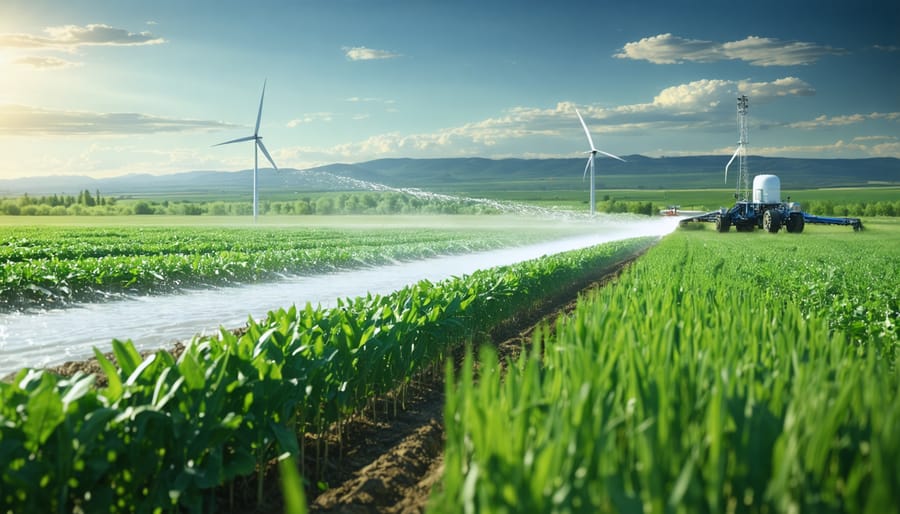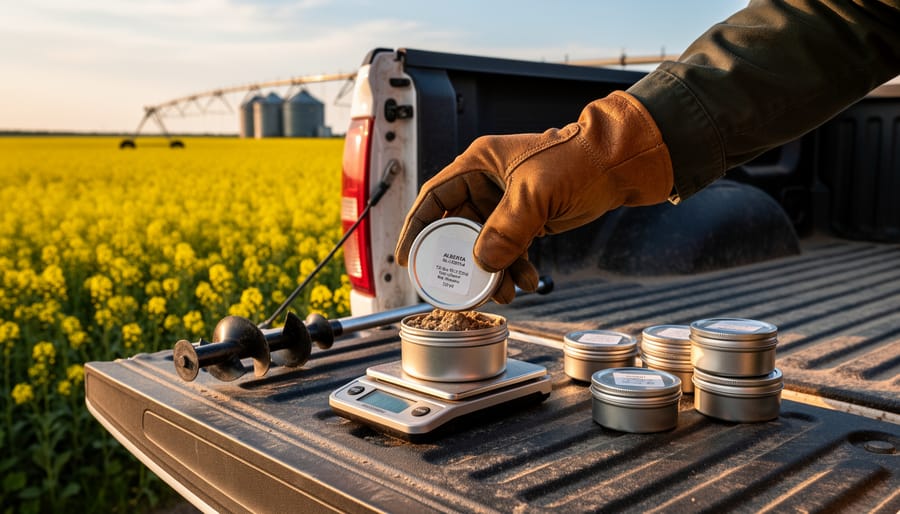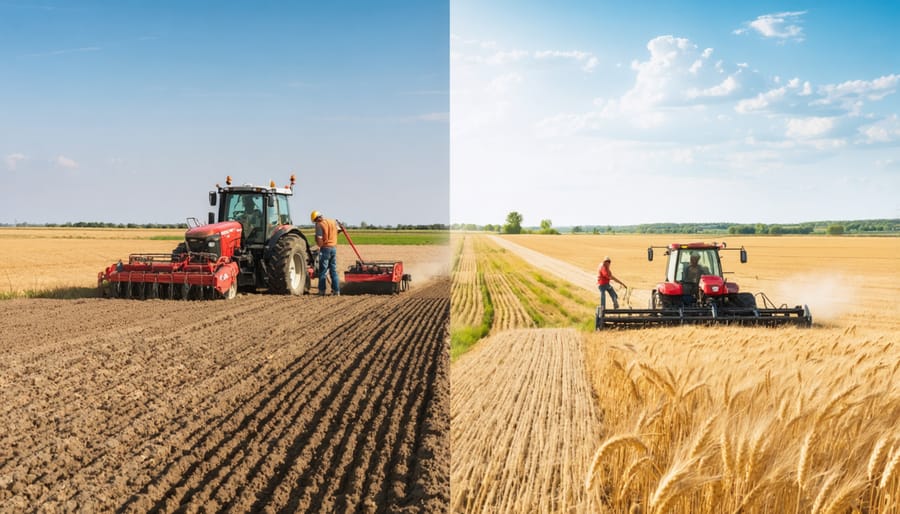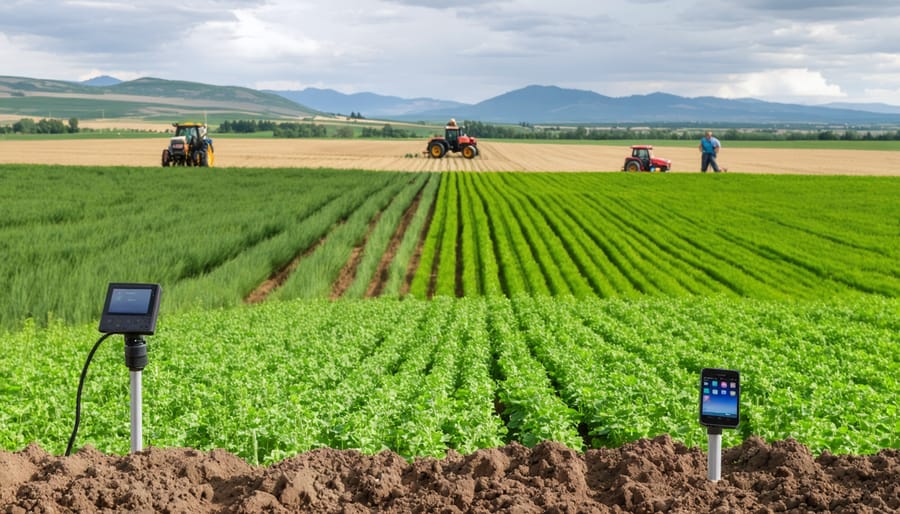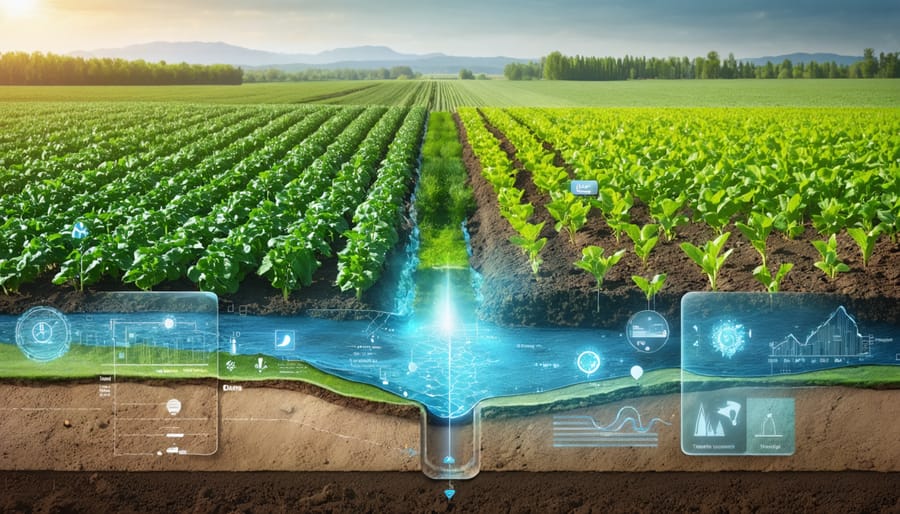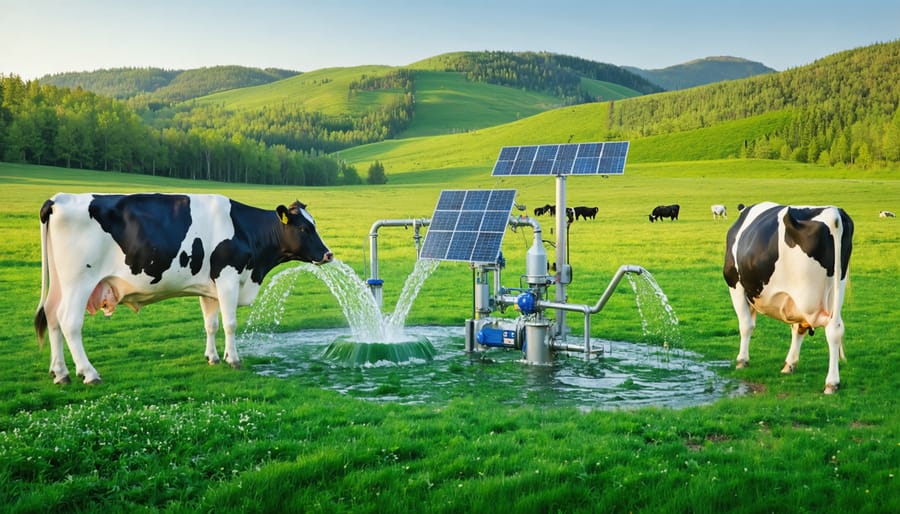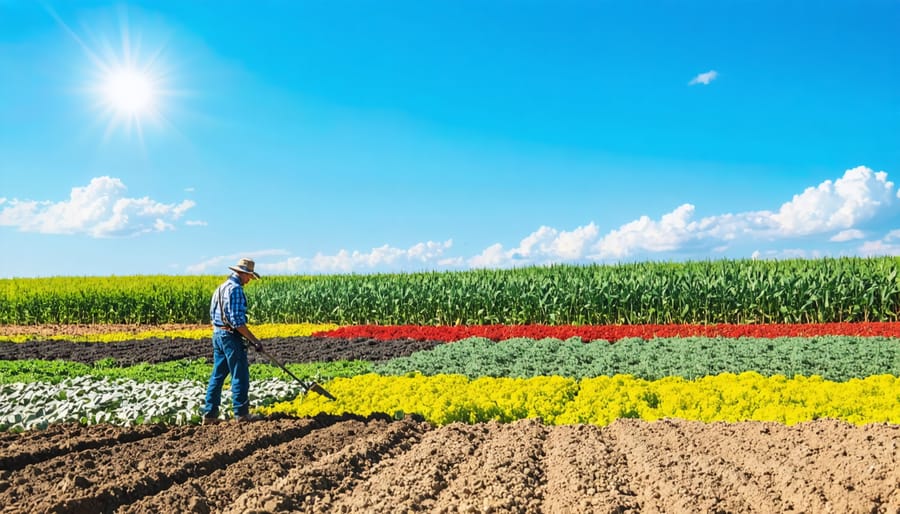The water-energy nexus stands at the heart of Alberta’s agricultural future, where every drop of water and kilowatt of energy shapes farm productivity and sustainability. On Alberta’s 43.7 million acres of farmland, irrigation systems consume nearly 40% of the province’s water resources while accounting for approximately 25% of agricultural energy use. This intricate relationship between water and energy management presents both challenges and opportunities for local farmers facing increasing pressure to optimize resources amid changing climate patterns.
For Alberta’s agricultural community, understanding the water-energy nexus isn’t just about conservation – it’s about smart business. Modern farming operations that implement integrated water-energy solutions typically reduce operational costs by 15-30% while maintaining or improving crop yields. These systems leverage advanced technologies like precision irrigation, energy-efficient pumping systems, and real-time monitoring to create a more resilient and profitable farming operation.
As water and energy costs continue to rise across the prairies, mastering this interconnection has become essential for maintaining competitive advantage in global markets. Through practical solutions and community-driven innovation, Alberta farmers are pioneering approaches that not only conserve resources but also strengthen the province’s position as a leader in sustainable agriculture.
The Water-Energy Connection on Alberta Farms
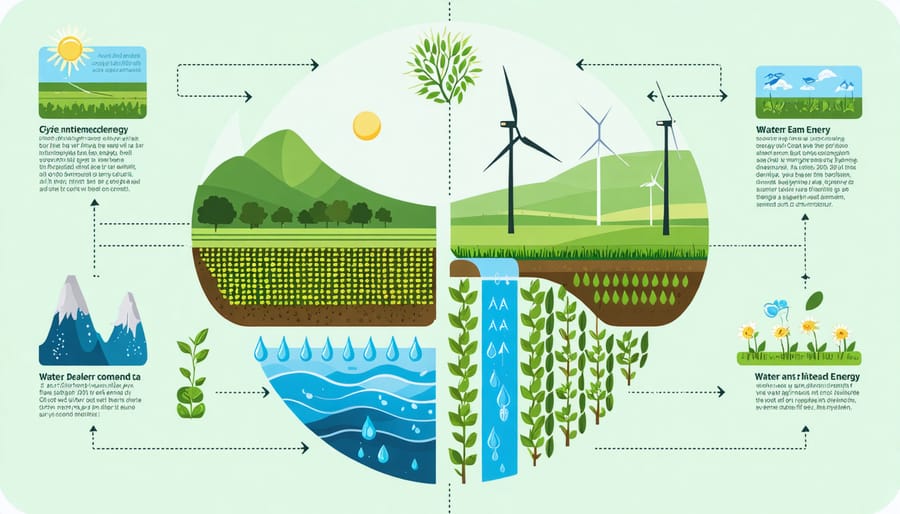
Current Water-Energy Usage Patterns
Alberta farms currently demonstrate distinct patterns in water and energy usage, with irrigation systems consuming approximately 40% of on-farm energy and accounting for nearly 70% of agricultural water use. A typical 1,000-acre farming operation in southern Alberta uses between 300,000 to 400,000 kilowatt-hours annually, with seasonal variations heavily influenced by irrigation demands.
Recent surveys show that most Alberta farmers rely on a combination of grid electricity and diesel fuel for their operations, with pumping systems being the largest energy consumers. Water usage patterns follow seasonal trends, peaking during the May-August growing season when irrigation demands are highest. The average farm uses about 350-400 millimetres of water per hectare during this period.
Interestingly, many Alberta farming operations still use traditional flood irrigation systems, which, while familiar, tend to be less efficient in both water and energy use. However, there’s a growing shift towards modern pivot irrigation systems, which can reduce water consumption by up to 30% and energy usage by 20% compared to conventional methods. This transition reflects an increasing awareness among farmers about the interconnected nature of water and energy resources in agricultural operations.
Impact on Farm Operating Costs
The impact on farm operating costs from inefficient water-energy practices can significantly affect a farm’s profitability. For many Alberta farmers, energy costs related to water management can account for 15-30% of their total operating expenses. Irrigation pumping alone typically consumes between 20,000 and 50,000 kilowatt-hours annually on a mid-sized farm, resulting in substantial electricity bills.
When considering water heating, cooling, and treatment systems, these costs can climb even higher. For example, a dairy operation in Red Deer reported saving $7,200 annually after implementing water-energy efficient practices, including variable frequency drives on their irrigation systems and heat exchangers for their water heating needs.
Storage and distribution inefficiencies can lead to additional hidden costs through water loss and increased pumping requirements. By addressing these issues through regular maintenance and system upgrades, farmers can typically reduce their water-related energy expenses by 20-40%, creating significant savings that can be reinvested in their operations.
Smart Integration Strategies That Work
Efficient Irrigation Technologies
Today’s modern irrigation systems are revolutionizing how Alberta farmers manage both water and energy resources. Variable Rate Irrigation (VRI) systems, equipped with smart sensors and GPS technology, allow farmers to precisely control water application based on specific field conditions, reducing water waste by up to 30% while cutting pump energy costs.
Drip irrigation systems, increasingly popular among Alberta vegetable and fruit growers, deliver water directly to plant roots through low-pressure tubing. These systems typically use 40-60% less water than traditional sprinklers and require significantly less energy to operate, as they maintain lower operating pressures.
Low-elevation spray application (LESA) systems have shown remarkable results in southern Alberta fields. By positioning sprinklers just above the crop canopy, these systems minimize water loss through evaporation and wind drift. Local farmers report energy savings of up to 25% compared to traditional centre pivot systems, while maintaining or improving crop yields.
Soil moisture monitoring tools and weather-based irrigation scheduling help farmers optimize their irrigation timing. When combined with automated controls, these technologies can reduce unnecessary system operation, leading to substantial energy savings while ensuring crops receive exactly what they need, when they need it.

Energy Recovery Systems
Energy recovery in water systems represents a significant opportunity for Alberta farmers to reduce operational costs while promoting sustainability. Several innovative methods are currently being implemented across the province, showing promising results for both small and large-scale operations.
Pressure reduction turbines, installed at points where water pressure needs to be lowered, can generate electricity from what would otherwise be wasted energy. For example, the Henderson family farm near Red Deer installed a micro-turbine system in their irrigation network, generating enough power to offset 30% of their pump house electricity consumption.
Heat exchangers are another effective solution, particularly valuable in dairy operations where both heating and cooling are required. These systems capture waste heat from milk cooling processes and redirect it for water heating, significantly reducing energy costs. Several Alberta dairy farmers report energy savings of up to 40% after implementing these systems.
Biogas recovery from wastewater treatment is gaining traction, especially on larger livestock operations. The Mackenzie Valley Farm Cooperative recently implemented a biodigester system that processes manure and wastewater, generating enough methane to power their entire dairy operation.
For smaller operations, simple gravity-fed systems can be designed to minimize pumping requirements while maximizing natural water flow. These systems require careful initial planning but offer long-term energy savings with minimal maintenance needs. Local agricultural extension services offer free consultations to help farmers assess which energy recovery systems best suit their specific needs and terrain.
Monitoring and Automation
Modern farming operations are increasingly turning to smart monitoring solutions to optimize their water and energy usage. These automated systems use sensors and data analytics to track resource consumption in real-time, helping Alberta farmers make informed decisions about irrigation scheduling and energy management.
Remote monitoring systems can now track soil moisture levels, weather conditions, and pump performance from a smartphone or tablet. Many local farmers have implemented automated irrigation controllers that adjust water delivery based on real-time soil moisture data and weather forecasts, reducing both water waste and energy consumption.
For example, the Thompson family farm near Lethbridge saved 30% on their irrigation energy costs after installing smart meters and automated controls. Their system automatically adjusts pump speeds based on pressure requirements and shuts down sections not requiring irrigation, preventing unnecessary energy use.
Several cost-sharing programs are available through Alberta’s agricultural services to help farmers implement these technologies. Local irrigation districts often provide training and technical support for setting up monitoring systems. Consider starting with basic soil moisture sensors and gradually expanding to more comprehensive automation as you become comfortable with the technology.
Remember to regularly calibrate and maintain your monitoring equipment to ensure accurate readings and optimal performance. Many successful Alberta farmers have found that the initial investment in automation pays for itself through reduced resource costs and improved crop yields.

Alberta Success Stories
Southern Alberta Dairy Farm Case Study
The Henderson Family Dairy Farm in Lethbridge County stands as a compelling example of successful water-energy integration in Alberta’s agricultural sector. Since implementing their integrated system in 2018, the 200-head dairy operation has reduced water consumption by 40% and energy costs by 35%.
At the heart of their system is a closed-loop water recycling process that captures, treats, and reuses water from various farm operations. The washing system for the milking parlour incorporates heat exchangers that recover thermal energy from warm wash water, which is then used to preheat water for the next cleaning cycle and maintain optimal temperatures in cattle drinking water during winter months.
The farm installed a 75-kilowatt solar array on their barn roof, which powers their efficient variable-speed vacuum pumps and milk cooling systems. During peak summer months, excess solar energy is used to power their irrigation systems, significantly reducing reliance on grid electricity.
Most notably, the Hendersons implemented an innovative manure management system that captures methane for biogas production, providing supplementary power for their operations. The nutrient-rich effluent is used for precision irrigation, reducing chemical fertilizer needs while optimizing water usage.
“The initial investment was substantial,” notes Sarah Henderson, “but the operational savings and environmental benefits have made it worthwhile. We’re now helping other local dairy farmers implement similar systems.”
Central Alberta Crop Farm Innovation
The MacDonald Family Farm in Red Deer County has become a stellar example of water-energy optimization in central Alberta’s agricultural sector. In 2020, the MacDonalds implemented a smart irrigation system that reduced their water consumption by 35% while maintaining crop yields across their 2,000-hectare operation.
The system combines soil moisture sensors, weather monitoring stations, and automated irrigation controls to deliver precise amounts of water when and where needed. Solar-powered pumps manage water distribution, cutting energy costs by approximately $12,000 annually. The MacDonalds also installed variable frequency drives on their irrigation equipment, which adjust pump speeds based on real-time demand.
“It’s about working smarter, not harder,” says Sarah MacDonald, who manages the farm’s technical operations. “We’re saving water and energy while producing the same amount of canola and wheat. The initial investment paid for itself within three growing seasons.”
The farm’s success has inspired neighbouring operations to adopt similar practices. The local agricultural extension office now uses the MacDonald Farm as a demonstration site for their water-energy efficiency workshops. Their experience shows that when farmers optimize both water and energy use together, rather than treating them as separate challenges, the benefits multiply across the operation.
The MacDonalds continue to fine-tune their system, sharing their learnings through the Central Alberta Agricultural Society’s monthly meetings and mentor program.
Getting Started with Integration
Assessment and Planning
Evaluating your farm’s water-energy system starts with a comprehensive audit of current practices and resource usage. Begin by documenting your water sources, energy consumption patterns, and seasonal variations in demand. Consider partnering with local agricultural extension services or consulting firms that specialize in agricultural resource management to conduct professional assessments.
When planning improvements, focus on implementing water conservation strategies that align with your energy goals. Create a detailed inventory of your irrigation systems, pumping equipment, and energy sources. Pay special attention to peak usage periods and identify opportunities for load shifting or efficiency upgrades.
Set realistic targets for both water and energy reduction, aiming for a 15-20% improvement in the first year. Consider factors like soil type, crop requirements, and local climate patterns when developing your action plan. Many Alberta farmers have found success by breaking down their implementation strategy into seasonal phases, allowing for careful monitoring and adjustment of new systems.
Remember to factor in available government incentives and rebate programs when budgeting for improvements. The Alberta Farm Energy and Agri-Processing Program often provides support for farmers implementing water-energy efficiency measures. Document your baseline measurements and track progress regularly to ensure your investments are delivering the expected returns.
Available Support and Resources
Alberta farmers looking to optimize their water-energy systems have access to numerous support programs and resources. The Canadian Agricultural Partnership (CAP) offers grants of up to $50,000 for implementing energy-efficient irrigation systems and renewable energy solutions on farms. Through Growing Forward 3, producers can access technical assessments and funding for water conservation projects.
The Alberta Irrigation Management Program provides free consultation services and tools to help farmers optimize their irrigation scheduling and reduce energy costs. Local agricultural extension offices offer one-on-one support, workshops, and educational materials tailored to regional needs.
For technical expertise, the Alberta Agriculture Water Engineers are available to assist with system design and efficiency improvements. They provide free initial consultations and can help farmers navigate various funding applications.
Several utilities companies, including ATCO and ENMAX, offer energy audit services and rebates for agricultural operations. The Agriculture Financial Services Corporation (AFSC) provides low-interest loans specifically for water and energy infrastructure improvements.
The Environmental Farm Plan program helps producers identify opportunities for improving water and energy management while potentially qualifying for additional funding streams. Regular workshops are held throughout the province, connecting farmers with experts and fellow producers who have successfully implemented water-energy solutions.
For comprehensive support, the Alberta Federation of Agriculture maintains an online resource hub with case studies, technical guides, and funding updates specific to water-energy management in agriculture.
The integration of water and energy systems on Alberta farms represents a significant opportunity for our agricultural community to lead in sustainable farming practices. By implementing water-energy solutions, we’ve seen farmers reduce operational costs by up to 30% while contributing to environmental conservation. The success stories from local farms demonstrate that these systems work effectively in our climate and conditions. Whether you’re starting with simple efficiency measures or planning a comprehensive system overhaul, every step toward water-energy integration makes a difference. Together, we can build a more resilient and sustainable agricultural sector that benefits our farms, communities, and future generations. Take the first step today by connecting with local agricultural extension services or joining farmer-led initiatives focused on water-energy solutions. The resources and support are available – let’s work together to make positive changes on our farms.

